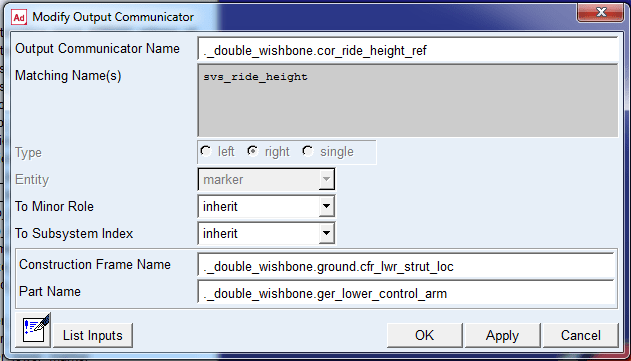We're switching from /chassis to /car for reasons that have never been entirely clear, and i believe that MSC will cease to support /chassis once we abandon it (maybe you could check with them). If they are going to support it down the track then yes, it is a lot easier to customise. For a start the marker ids are fixed, so you can write little bits of code like this, which is magically generated in excel:
********************************
* *
* FRONT SIMPLE STABILIZER BAR *
* Greg Locock v1.1 for GL9h3 *
********************************
MARKER/110465,PART=102 LEFT FRONT STABILIZER LINK TO ext
, QP=1660.00,-630.00,477.00
, ZP=1629.00,-629.00,601.00
MARKER/110566,PART=103 RIGHT FRONT STABILIZER LINK TO ext
, QP=1660.00,630.00,477.00
, ZP=1629.00,629.00,601.00
MARKER/114961,PART=149 LEFT FRONT STABILIZER BAR TO ext
, QP=1907.00,-339.00,469.00
, ZP=1907.00,339.00,469.00
MARKER/114962,PART=149 RIGHT FRONT STABILIZER BAR TO frame
, QP=1907.00,339.00,469.00
, ZP=1907.00,-339.00,469.00
adams_view_name='gel_Stabilizer_Bar_FRONT'
PART/132,CM=13200,MASS= 1.47,IP=6.4600e+04,7.3700e+01,6.4600e+04
, 0.0000e+00,0.0000e+00,0.0000e+00
M/13200,QP=1907.00,-314.50,469.00
M/13250,QP=1907.00,0.00,469.00
, ZP=1907.00,-339.00,469.00
M/13261,QP=1907.00,-339.00,469.00
, ZP=1907.00,339.00,469.00
M/13263,QP=1629.00,-629.00,601.00
M/13211,QP=1907.00,0.00,469.00
, ZP=1907.00,-339.00,469.00
M/13210,QP=1907.00,-629.00,469.00
, ZP=1629.00,-629.00,601.00
adams_view_name='ger_Stabilizer_Bar_FRONT'
PART/133,CM=13300,MASS= 1.47,IP=6.4600e+04,7.3700e+01,6.4600e+04
, 0.0000e+00,0.0000e+00,0.0000e+00
M/13300,QP=1907.00,314.50,469.00
M/13350,QP=1907.00,0.00,469.00
, ZP=1907.00,-339.00,469.00
M/13362,QP=1907.00,339.00,469.00
, ZP=1907.00,-339.00,469.00
M/13364,QP=1629.00,629.00,601.00
M/13311,QP=1907.00,0.00,469.00
, ZP=1907.00,339.00,469.00
M/13310,QP=1907.00,629.00,469.00
, ZP=1629.00,629.00,601.00
SPRING/165,ROT,I=13250,J=13350,CT=0,KT=4300000,A=0.0 FRONT STABILIZER BAR
SPRING/163,TRA,I=110465,J=13263,K=1.0000e+05,C= 25.0 LEFT STABILIZER BAR LINK
, L= 127.82
SPRING/164,TRA,I=110566,J=13364,K=1.0000e+05,C= 25.0 RIGHT STABILIZER BAR LINK
, L= 127.82
JOINT/161,REV,I=13261,J=114961 LEFT STABILIZER BAR TO SUBFRAME
JOINT/162,REV,I=13362,J=114962 RIGHT STABILIZER BAR TO SUBFRAME
GRA/15030,CYL,CM=13210,SEG=6,RAD= 10.55,LEN= 307.746649047557 LEFT STABILIZER BAR
GRA/15031,CYL,CM=13211,SEG=6,RAD= 10.55,LEN= 629 LEFT STABILIZER BAR
GRA/15032,CYL,CM=13310,SEG=6,RAD= 10.55,LEN= 307.746649047557 righT STABILIZER BAR
GRA/15033,CYL,CM=13311,SEG=6,RAD= 10.55,LEN= 629 STABILIZER BAR
GRA/13394,SPDP,I=110465,J=13263,DB= 21.10,LA=2 LEFT STABILIZER BAR LINK
, LC= 89.47,DC= 21.10,LB=2,LD= 89.47
GRA/13395,SPDP,I=110566,J=13364,DB= 21.10,LA=2 RIGHT STABILIZER BAR LINK
, LC= 89.47,DC= 21.10,LB=2,LD= 89.47
!Torsion bar requests
REQ/13350,FOR,I=13250,J=13350,RM=13350
, C=SIMPLE STA BAR WINDUP FORCE (N & Nmm)
REQ/13351,DIS,I=13250,J=13350,RM=13350
, C=SIMPLE STABAR BAR WINDUP ANGLE (mm & deg)
!END of SIMPLE STA BAR
!
and include them in the model.
This is more or less how Chassis started out many moons ago, written by engineers for engineers.
Cheers
Greg Locock
New here? Try reading these, they might help FAQ731-376



